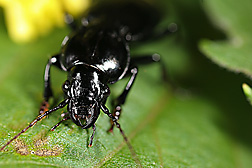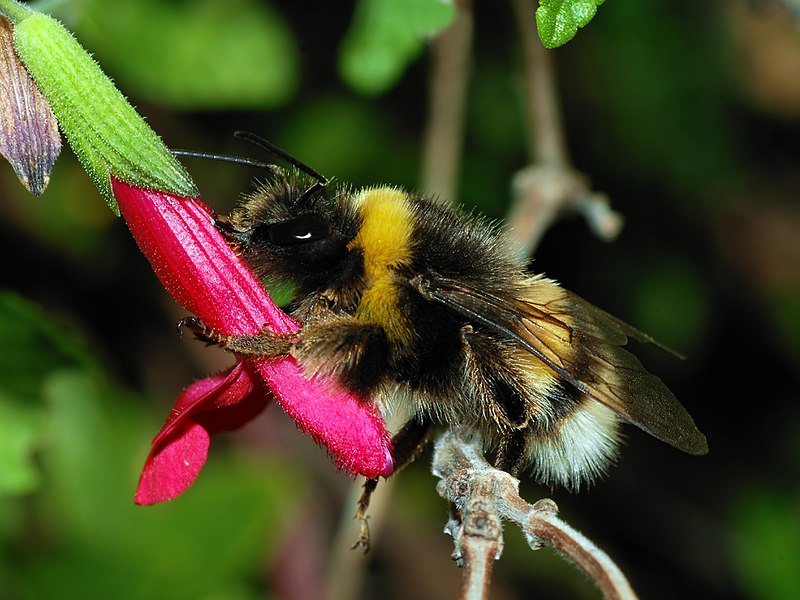
Thursday, November 19, 2009
Bigger is not always better...

Monday, November 9, 2009
Bed Bug Identification for Travelers
 Worried about bed bugs when you travel? Well now there is a tool to help you out. The "Bed bug identifier" is now available on iTunes for just $4.99. It includes photos of the different life stages, where to look for bed bugs in your hotel room, tips, insects that look like bed bugs and more...
Worried about bed bugs when you travel? Well now there is a tool to help you out. The "Bed bug identifier" is now available on iTunes for just $4.99. It includes photos of the different life stages, where to look for bed bugs in your hotel room, tips, insects that look like bed bugs and more...Bed Bug Itunes app.
Want to learn more about bed bugs?
- Bed bugs University of KY
- The Bedbug Registry (where have the little suckers been reported)
- Wikipedia bed bugs
Sunday, November 1, 2009
Kinder, Gentler Spider Eats Veggies, Cares for Kids
 Who knew there was a vegetarian spider, Bagheera kiplingi. From Central America, it feeds on Acacia trees and helps care for its young, very unheard of in the spider world. Read more here
Who knew there was a vegetarian spider, Bagheera kiplingi. From Central America, it feeds on Acacia trees and helps care for its young, very unheard of in the spider world. Read more here
IPM celebrates 50 years!
Fifty years ago in October, four pioneering University of California scientists outlined a new way of thinking about pest control, establishing a pest management framework that changed the way the world farms.
Read the rest in California Agriculture magazine "The 50th anniversary of a great idea"
Wednesday, October 28, 2009
Name change for Hypoaspis miles

Where can you buy Stratiolaelaps scimitus (Hypoaspis miles) ? Syngenta Bioline, Applied Bionomics, BioBest, or Koppert.
Key to Adult females of Species of Stratiolaelaps (from Walter & Campbell 2002)
Tuesday, October 6, 2009
Texas is looking into the beneficials that work at night...
 Entomologist Bob Pfannenstiel and other ARS scientists down in Texas have been looking into beneficials that come out and feed at night. The have been doing this for 8 years now and have discovered many interesting things. Like the Asian cockroach, Blattella asahinai is a predatory on moth eggs. They also found nocturnal cursorial spiders to be moth egg predators as well. Learn more by reading the article on the ARS USDA website! Working After Hours A Nighttime View of Insect Predation
Entomologist Bob Pfannenstiel and other ARS scientists down in Texas have been looking into beneficials that come out and feed at night. The have been doing this for 8 years now and have discovered many interesting things. Like the Asian cockroach, Blattella asahinai is a predatory on moth eggs. They also found nocturnal cursorial spiders to be moth egg predators as well. Learn more by reading the article on the ARS USDA website! Working After Hours A Nighttime View of Insect PredationTuesday, September 15, 2009
Syngenta to boost pollinators across Europe
Thursday, August 27, 2009
Koppert launches biological control in Ecuador
Saturday, August 8, 2009
Diaprepes root weevil

Wednesday, July 15, 2009
Friday, July 3, 2009
Beneficial Nematodes
Tuesday, June 23, 2009
Happy National Pollinator Week!!
 Beeing (hahah) its National Pollinator Week thought I put up some links to some cool website. Like Save the Bumblebees, http://www.savethebumblebees.com/. It has links to keys and other helpful information.
Beeing (hahah) its National Pollinator Week thought I put up some links to some cool website. Like Save the Bumblebees, http://www.savethebumblebees.com/. It has links to keys and other helpful information.Looking for images of bumblebees? Check out Bug Guides image gallery for the genus Bombus.
Another cool site on pollinators. North American Pollinators Protection Campaign.
and The North American Pollinator Protection Campaign and The Pollinator Partnership
Amblyseius (Typhlodromips) swirskii

Tuesday, June 9, 2009
Plant parasitic nematodes better watch out!

Friday, June 5, 2009
New Weapon in the Deer Tick War

Cornell Cooperative Extension is now testing a new deer feeder on Shelter Island. It's a feeder that passively applies a tickicide to the deer's head and neck as they feed. This will kill the deer ticks that vector lymes diseases. Read more....
Floriculture Sector and Vineland Research and Innovation Centre Partner to Establish Biocontrol Research Program
New EAB Insecticide Bulletin is Available Now
 Looking for the most up to date info on Emerald Ash Borer? There is now a downloadable piece of literature that will provide you with all the information you need.
Looking for the most up to date info on Emerald Ash Borer? There is now a downloadable piece of literature that will provide you with all the information you need.Insecticide Options for Protecting Ash Trees From Emerald Ash Borer
More emerald ash borer (EAB)
Catnip driving away pest ladybugs
Tuesday, May 26, 2009
Beetles Are Inspiration for Coatings
Thursday, May 21, 2009

Escargot anyone? Eleven-year-old Fin Keheler let 43 slimy snails crawl trying to set the Guinness World Record. Read more
Tuesday, May 19, 2009
Bee Decline
Preliminary Results: A Survey of Honey Bee Colonies Losses in the U.S. Between September 2008 and April 2009.
The Apiary Inspectors of America (AIA) and USDA-ARS Beltsville Honey Bee Lab conducted a survey between September 2008 and early April 2009 to estimate colony loses across the country. Over 20% of the country’s estimated 2.3 million colonies were surveyed. A total loss of 28.6% of managed honey bee colonies was recorded. This compares to losses of 35.8% and 31.8% recorded respectively in the winters of 2007/2008 and 2006/2007. While a decrease in total losses is encouraging, the rate of loss remains unsustainable as the average operational loss increased from 31% in 2007/2008 to 34.2% in the 2008/2009 winter. Read on
Monday, May 18, 2009
U.S. organic sales grow by a whopping 17.1 percent in 2008
Emerald ash borer has been found in Minnesota

Sunday, May 3, 2009
Music For Pest Managment
 I have never been a Led Zeppelin fan so it looks like morman crickets and I have something in common. Residents of Tuscarora, Nevada have been playing Led Zeppelin and Rolling Stones tunes to help drive these pesky crickets away. This is a truely a great way to control pests without pesticides. Read more....
I have never been a Led Zeppelin fan so it looks like morman crickets and I have something in common. Residents of Tuscarora, Nevada have been playing Led Zeppelin and Rolling Stones tunes to help drive these pesky crickets away. This is a truely a great way to control pests without pesticides. Read more....
Wednesday, April 29, 2009
Slugs in Oregon

Tuesday, April 28, 2009
New Orchid Mealybug
 And another new pest insect... Orchid Mealybug, Pseudococcus dendrobiorum Williams (Hemiptera: Pseudococcidae) was collected on March 27, 2009 off of an Phalaenopsis orchid in Florida and was identified on April 2, 2009. This is new to this hemosphere and to the continental US.
And another new pest insect... Orchid Mealybug, Pseudococcus dendrobiorum Williams (Hemiptera: Pseudococcidae) was collected on March 27, 2009 off of an Phalaenopsis orchid in Florida and was identified on April 2, 2009. This is new to this hemosphere and to the continental US.Monday, April 27, 2009
Plants Taking Up Antibiotics From Manures
A study has shown that antibiotics commonly added to animal feed can be taken up by plants that use manures for fertilization. In one study the test crops were corn (Zea mays L.), green onion (Allium cepa L.), and cabbage (Brassica oleracea L. Capitata group). Scientists found the higher the concentration in the manure, the higher the antibiotic levels were in the plants. Other research has looked at potato crops. That work found antibiotics in the potato tubers, which suggests that root crops which are directly in contact with soil may be particularly vulnerable to antibiotic contamination.
Antibiotic Uptake by Plants from Soil Fertilized with Animal Man
Crops absorb livestock antibiotics, science showsAntibiotic Uptake by Plants from Soil Fertilized with Animal Manure
U.S. National Arboretum is "going green"
 I think leading by example is an excellent idea... and it looks like the government is trying to do that. The U.S. National Arboretum installed its first solar-powered drip irrigation system that will save electricity and water at the 446-acre facility. It is run by the Agricultural Research Service (ARS) in Washington, DC.
I think leading by example is an excellent idea... and it looks like the government is trying to do that. The U.S. National Arboretum installed its first solar-powered drip irrigation system that will save electricity and water at the 446-acre facility. It is run by the Agricultural Research Service (ARS) in Washington, DC.Read more here
Sunday, April 26, 2009
Evaluation of predatory mites Neoseiulus cucumeris and Amblyseius swirskii for control of Chilli thrips.
 The USDA ARS has posted reserach results from work being done on Chilli thrips, Scirtothrips dorsalis (Thysanoptera: Thripidae). The work was done on peppers using Neoseiulus cucumeris and Amblyseius swirskii (Acari: Phytoseiidae). Publication Date: January 20, 2009
The USDA ARS has posted reserach results from work being done on Chilli thrips, Scirtothrips dorsalis (Thysanoptera: Thripidae). The work was done on peppers using Neoseiulus cucumeris and Amblyseius swirskii (Acari: Phytoseiidae). Publication Date: January 20, 2009Wednesday, April 22, 2009
Online Training for Retail Employees

The University of California is now offering online training for retail employees on pesticides. It provides a training course for retail and garden center employees and others who advise residents about home and garden pesticides.
EPA Will Mandate Tests On Pesticide Chemicals
Researchers have raised concerns that chemicals released into the environment interfere with animals' hormone systems, citing problems such as male fish in the Potomac River that are bearing eggs. Known as endocrine disruptors, the chemicals may affect the hormones that humans and animals produce or secrete. Read more
Tuesday, April 21, 2009
IPM Twitter Reports
 For all of you in the Pacific North West there is a new way to keep up with pest problems using Twitter. The PNW Nursery IPM report will send out updates via Twitter. All you have to do is have a Twitter account and sign up for the updates. Its FREE and easy !
For all of you in the Pacific North West there is a new way to keep up with pest problems using Twitter. The PNW Nursery IPM report will send out updates via Twitter. All you have to do is have a Twitter account and sign up for the updates. Its FREE and easy !Monday, April 13, 2009
Ladybugs - Should you buy them?
 With spring arriving many gardeners are looking to be more “green” or even organic. There are many ways to do this but one area many are interested in is pest management. Unfortunately people’s good efforts are not always so eco-friendly. From the time we are young we are told that ladybugs (ladybird beetles) are good, and they are! They are excellent to have in the garden, but the real question is, “should you buy them and release them?”
With spring arriving many gardeners are looking to be more “green” or even organic. There are many ways to do this but one area many are interested in is pest management. Unfortunately people’s good efforts are not always so eco-friendly. From the time we are young we are told that ladybugs (ladybird beetles) are good, and they are! They are excellent to have in the garden, but the real question is, “should you buy them and release them?”Buying ladybugs… is it a good idea?
First thing you should think about is where they are coming from. Almost all “red” ladybugs are
 harvested from the wild. In the Spring, as the Sacramento and San Joaquin Valleys warm up the ladybugs (Hippodamia convergens) migrate to the Sierra Nevada foothills. There, they congregate in large numbers on the forest floors. Businesses then come along and scoop up the beetles, removing them from their native habitat. They are then taken to coolers for storage until they are to be shipped. So, why is this an issue?
harvested from the wild. In the Spring, as the Sacramento and San Joaquin Valleys warm up the ladybugs (Hippodamia convergens) migrate to the Sierra Nevada foothills. There, they congregate in large numbers on the forest floors. Businesses then come along and scoop up the beetles, removing them from their native habitat. They are then taken to coolers for storage until they are to be shipped. So, why is this an issue?- It removes ladybugs from their native habitat.
- Once released most will not stick around, they leave, providing little or no control.
- A percent of the ladybugs may be parasitized by a small wasp, Dinocampus coccinellae. It develops as an internal parasite of lady beetles and kills them. Research has shown this to be an issue. A study found on average 8% of the ladybugs purchased by researchers carried parasites.*
- Microsporidia, a disease of ladybugs, was also detected in individuals from 13 of 22* shipments in these studies.
So by releasing infected ladybird beetles you may be spreading these parasites and diseases. It’s much more effective and eco-friendly to attract them in naturally with organically** grown plants like, dill, yarrow, sunflowers, angelica, and other assorted flowering plants. If you want to do a release of beneficial insects, release laboratory reared ones. An excellent option to ladybugs are green lacewings. The larva of green lacewings will do an excellent job of feeding on plant pests such as aphids, mealybug crawlers, scale crawlers and other garden pests. They are commercially available from Beneficial Insectary.
*Natural enemies of the convergent lady beetle, Hippodamia convergens Guérin-Méneville: Their inadvertent importation and potential significance for augmentative biological control. S. Bjørnson Department of Biology, Saint Mary’s University, 923 Robie Street, Halifax, NS, Canada B3H 3C3 Abstract** Organically grown plants will not have harsh pesticide residue on them that can kill the beneficials. They will also not have systemic pesticides inside of them that can not be washed off.
Friday, April 3, 2009
Growing a Greener World Podcast

Thursday, April 2, 2009
Fire Ants on the Move Again !

You can read more here at the North American Plant Protection Organization's (NAPPO) Phytosanitary Alert System website.
Wednesday, April 1, 2009
'Hey I'm Dead!' The Story Of The Very Lively Ant
I heard this story while drive around today on NPR. What first caught my attention was the voice, it sounded familiar, and sure enough it was. It was E.O. Wilson, the most knowledge person on ants in the world. In this article and interview he talks about how ants know when other ants are dead. Very interesting!
See and hear the story here 'Hey I'm Dead!' The Story Of The Very Lively Ant
Go D'Hara
Monday, March 30, 2009
Pesticides and How They Impact Biological Control Agents

Go D'Hara
Sunday, March 29, 2009
International IPM Symposium
What Snyder’s team is looking at is when beneficial insects are around pest insects but have not been killed, the pests are more likely to be killed by beneficial fungus or beneficial nematodes. They think the beneficials stress the pest, making them more susceptible to the pathogens.
Also, researchers from the University of Florida stressed for thrips management the importance of conserving native beneficials. They have found that by spraying pesticides for western flower thrips it actually causes more western flower thrips problems in the long run. They said it is better to use spray products that are soft on the beneficials, and to limit those sprays so native beneficials can get to work. They also discussed the many different native species of thrips and how they can outcompete western flower thrips.
Go D'hara





